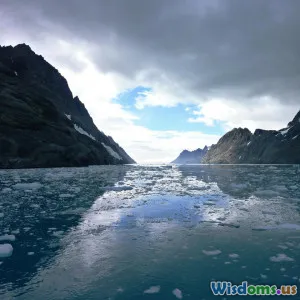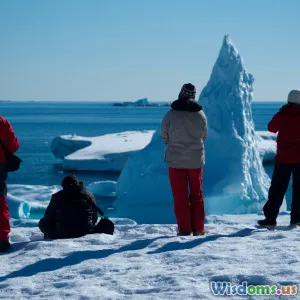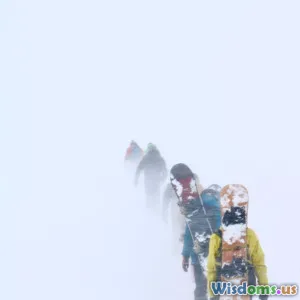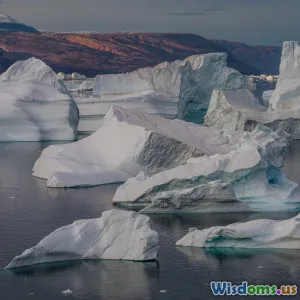
How to Prepare for a Month Living Among Antarctic Glaciers
10 min read Essential guide to surviving and thriving during a month-long stay among Antarctic glaciers. (0 Reviews)
How to Prepare for a Month Living Among Antarctic Glaciers
Living among Antarctic glaciers — a forbidding, icy wilderness unlike anywhere else on Earth — is not only a test of physical endurance but also a challenge to mental resilience, preparation, and adaptability. Whether you are a scientist undertaking field research, an adventurous traveler, or part of a support crew, spending an entire month in this extreme environment demands meticulous planning and an informed approach.
This article breaks down everything you need to know about preparing for a month-long expedition in Antarctica’s glacier-studded landscape. From equipment necessities, clothing innovations, and nutrition plans to understanding environmental hazards and mental health management, prepare to immerse yourself mentally and physically in the tundra of extremes.
Understanding the Antarctic Environment: A Prelude to Preparation
Before diving into practical preparation tips, it’s crucial to grasp the unique characteristics of the Antarctic environment:
- Extreme temperatures: Antarctic winter temperatures regularly plunge below -40°F (-40°C), but even during summer months, temperatures hover between 14°F and 32°F (-10°C to 0°C). Wind chills can make conditions feel substantially colder.
- Unpredictable weather: Sudden whiteouts, fierce katabatic winds that can reach over 100 mph (160 km/h), and intense UV radiation due to ozone depletion add layers of complexity.
- Remote and isolated: Medical assistance can be hours or days away. Communication is limited, often reliant on satellite technology.
- Glacier dynamics: Crevasses, unstable ice, and avalanche risks require constant vigilance.
Understanding these environmental factors set the tone for preparation focusing on safety, communication, clothing, and mental readiness.
Gear Up: Critical Equipment and Clothing
Antarctica's hostile climate mandates specialized gear to ensure your safety and comfort.
Clothing Layers: The Art of Staying Warm
Thermal regulation through layering is vital:
- Base layer: Moisture-wicking fabrics such as merino wool or synthetic fibers to keep skin dry.
- Mid layer: Insulating materials like fleece or down for heat retention.
- Outer shell: Waterproof, windproof, and breathable jackets and pants to protect against wind and snow.
- Accessories: Balaclavas, insulated gloves, double pairs of socks, and UV-protection goggles are vital.
Example: Researchers at McMurdo Station rely on multiple insulated layers, including the 'Norton Suit,' a specialized outer suit tailored for Antarctic fieldwork, providing both windproofing and insulation.
Sleeping Systems
High-quality sleeping bags rated for temperatures below -30°F (-34°C) such as those filled with goose down or synthetic alternatives are essential. Using insulated sleeping pads with closed-cell foam technology adds ground insulation.
Navigation & Communication Equipment
- GPS devices with backup: Compass and physical maps remain essential due to electromagnetic anomalies.
- Satellite phones and emergency beacons: For regular check-ins and emergency contact.
Safety Tools
- Crampons and ice axes: Necessary when traversing icy terrain.
- Crevasse rescue kits: Harnesses, ropes, pulleys, and anchors for glacier travel.
- Portable shelters: Sturdy, four-season tents designed for strong winds and snow accumulation.
Nutrition: Fueling Your Body in Severe Conditions
Living in cold extremes increases caloric needs dramatically; some estimates show that Antarctic explorers may require 4,500 to 6,000 calories per day.
Caloric Requirements and Nutrient Balance
Cold induces a higher metabolic rate to maintain body heat.
- High-calorie diets: Focus on dense fats and carbohydrates.
- Protein intake: Maintains muscle mass and supports bodily functions, especially in physically exhausting environments.
Efficient Meal Planning
- Freeze-dried meals: Lightweight and nutrient-dense, ideal for field consumption.
- Energy bars and nuts: Quick energy boosts during hikes or scientific work.
- Hydration: Though cold springs less thirst urge, staying hydrated ensures optimal function. Use insulated water bottles to prevent freezing.
Notable example: The British Antarctic Survey provides its team members with meals rich in honey, nuts, chocolate, and dehydrated berries to boost energy and flavor.
Mental Preparation and Psychological Health
Isolation, monotony, extreme cold, and logistical barriers can take a toll on mental health.
Anticipating Psychological Challenges
- Isolation and loneliness: Limited social interactions in a confined team can lead to stress.
- Monotony and sensory deprivation: The landscape’s vast white can dull senses.
- Sleep disturbances: Polar day or night cycles disrupt circadian rhythms.
Strategies for Coping
- Establish routines: Scheduled activities and chores promote normalcy.
- Maintain communication: Regular contact with loved ones supports morale.
- Mental exercises: Reading, puzzles, music, or journaling help maintain cognitive engagement.
Research published in the journal Polar Psychology found that Antarctic expeditioners who developed strong interpersonal communication and personal coping skills reported better psychological well-being.
Physical Conditioning: Train Before You Go
Physical fitness is a critical foundation. Cold accelerates muscle fatigue and decreases dexterity.
Recommended Regimen
- Cardiovascular training: Builds endurance for trekking and manual labor.
- Strength training: Focus on legs, back, and core to manage carrying supplies and resisting wind forces.
- Flexibility and balance: Important for glacier navigation and reducing fall risk.
Before arriving at the Amundsen-Scott South Pole Station, many officials and scientists engage in months-long physical conditioning, stressing simulated cold exposure sessions to acclimatize muscles and performance.
Environmental Safety and Ethical Considerations
Protecting the Antarctic ecosystem and ensuring your safety necessitates knowledge and ethical stewardship.
Risk Management
- Weather protocols: Understanding how to listen and interpret meteorological forecasts.
- Glacier travel protocols: Travel roped-up in teams to mitigate crevasse dangers.
- Emergency drills: Regular practice of possible rescue operations.
Environmental Ethics
Antarctica is protected under the Antarctic Treaty System, emphasizing minimal human impact.
- Waste management: All waste must be brought back, avoiding contamination.
- Wildlife interaction: Keep distance from penguins, seals, and birds; avoid disturbing natural behaviors.
The National Science Foundation's Antarctic guidelines stress that preserving this pristine environment is as important as the scientific advances achieved there.
Real-World Insights: Voices from the Field
Dr. Elena Ramirez, a glaciologist who spent six months researching in Antarctica, emphasizes the significance of mental preparation: “The cold, immense silence, and isolation can be overwhelming. But meticulous prep, a reliable team, and an attitude of respect towards the environment make it manageable and profoundly rewarding.”
Similarly, expedition guide Mark Stevens attests that no amount of gear can replace adaptability and learning how to read the landscape, stating, "Mother Nature in Antarctica demands humility. Preparing your mind for unpredictability is just as critical as having the right clothing or food."
Conclusion: Embrace the Challenge with Knowledge and Respect
Living for a month amid Antarctic glaciers is an extraordinary endeavor demanding far more than just endurance. It requires an integrated approach—a blend of advanced preparation in gear, food, physical training, and mental stamina combined with rigorous adherence to safety and ethical standards.
Your survival and success depend on respecting the intimidating environment and thoroughly understanding how to operate within it. The reward? Experiencing one of the planet’s final frontiers firsthand—a landscape of staggering beauty, raw power, and humbling quiet. With the right preparation, your Antarctic adventure will not only be possible but profoundly transformative.
Embark on this challenge informed, prepared, and inspired to embrace the icy heart of our world.
References:
- National Science Foundation Antarctic Program
- British Antarctic Survey Field Guidelines
- Journal of Polar Psychology
- Personal communications with Dr. Elena Ramirez and Mark Stevens
- Antarctic Treaty System documentation
Rate the Post
User Reviews
Popular Posts


















